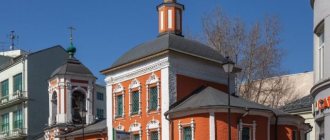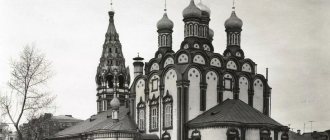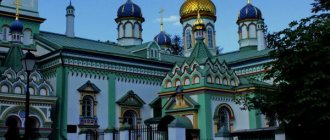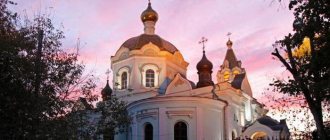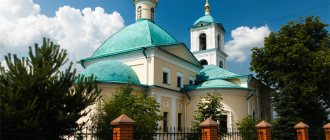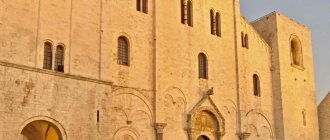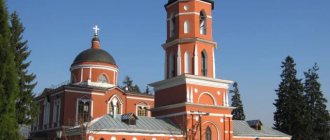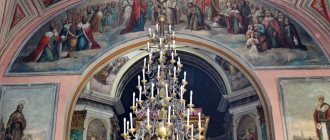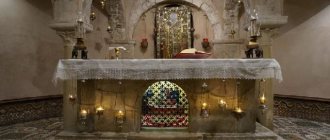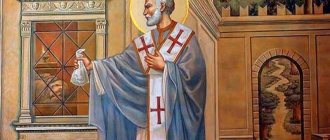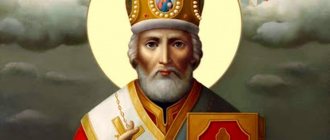The Church of St. Nicholas of Myra in old Vagankovo is significant in that it is located within the fence of the Russian State Library. This temple has a centuries-old history. The walls, erected in the 18th century, rest on an older foundation...
Many times during its long life, the temple was robbed by enemies and destroyed by fires, and each time, through the diligence of pious people, it was soon restored not only to its former, but even to better splendor.
From the historical essay “Temple of the Rumyantsev Museum” (1906)
The Leninka excursion bureau organizes excursions to the Church of St. Nicholas of Myra in old Vagankovo. They are conducted by the rector of the temple, Archpriest Boris Danilenko. Every Saturday at 16:00 anyone interested in the history of the temple can come on a tour. The events are free, but you need to sign up for them by calling the number listed on the tour desk website.
What does the name of the temple mean?
Ethnographer, folklorist, anthropologist, literary critic and writer Nikolai Andreevich Yanchuk suggests [1] that the name of the village of Vagankovo comes from the Northern Russian “vaganit”, that is, “play, make fun”. The researcher concluded that from time immemorial these places served for folk festivals, fist fights, amusing games - and this also explains the largest concentration of churches subsequently built in this place in Moscow - as if for the consecration of lands.
Of all the ancient temples of Vagankov, only one has survived to this day - the temple of St. Nicholas of Myra. The name of the temple also retains the name of the village where it was built - Staroe Vagankovo. This toponym gave the name to the lane where the entrance to the temple is located - Starovagankovsky.
The village of Vagankovo received the definition of “Old” in the 17th century, under Tsar Alexei Mikhailovich, who resettled some of the residents beyond Presnya, founding New Vagankovo there - and there, by the way, the Church of St. Nicholas was also built (on Three Mountains).
A lot of churches were built in honor of St. Nicholas on the territory of modern Znamenka, Vozdvizhenka and Sapozhkova Square - perhaps there was a cult of this saint: the churches of St. Nicholas in Vagankovo, St. Nicholas of Streletsky and St. Nicholas in Sapozhki, and also a little further, along Arbat: St. Nicholas the Revealed, St. Nicholas on Peski and St. Nicholas in Plotniki, and not far from them there is also the Church of St. Nicholas on Chicken Legs (on Molchanovka).
Photograph of the chapel in the name of St. Sergius, taken by N. A. Naydenov and published in 1884-1891. — link to the digitized version in the RSL electronic library
...For me - a free dream, the ringing of bells, Early dawns on Vagankovo. Marina Tsvetaeva. Poems about Moscow
History of the temple
Writer and local historian Ivan Fedorovich Tokmakov writes [2] that “the Church of St. Nicholas the Wonderworker, on Stary Vagankovo, was originally built in 1497 and here was the courtyard of the Nikolo-Pesnoshsky Monastery, in 1523 it was rebuilt again, and in 1530 a chapel was built in name Rev. Sergius."
At the end of the 17th century, the Church of St. Nicholas the Wonderworker on Stary Vagankovo had three altars and had two chapels: the right one in the name of St. Sergius, the left one in the name of the forty Sebastian martyrs, Christian soldiers who suffered for their faith in 320.
Engraving depicting a view of Pashkov's house at the beginning of the 19th century. Behind the palace you can see the churches: on the right is the Church of Mikhail Malein, broken at the end of the 18th century, and between it and the palace you can see the Church of St. Nicholas - this engraving is given by N. A. Yanchuk
In the 18th century the temple was rebuilt and completed. Nikolai Andreevich Yanchuk talks [1] about the difficult relationship between the rectors of the Church of St. Nicholas and the owners of the Pashkov house at the end of the 18th - beginning of the 19th centuries. From the founder, Pyotr Egorovich Pashkov, the palace passed to his cousin Alexander Ilyich Pashkov, who, as Yanchuk quotes, dismantled the chapel in the name of forty martyrs stone by stone: in the petition he wrote that the chapel “due to its dilapidation, only creates disgrace and takes up space in vain " From these stones, Alexander Pashkov built a fence around the temple - low, “so that it could not block a good view,” and surrounded the church with trees. This fence has survived to this day.
In addition, Pashkov bought more land next door to the Church of St. Nicholas and “built non-residential outbuildings, as a result of which a complaint arose from the priest of the Nikolo-Vagankovskaya Church that a parishioner of this church, Alexander Pashkov, did a disgrace at the church by building stables and stables around it,” to extreme constraint of the temple."
Photo from the book “Temple of the Rumyantsev Museum” (1906)
Pages from the history of the Church of St. Nicholas the Wonderworker in Klenniki
The Church of St. Nicholas in Klenniki, an architectural monument of the 17th-18th centuries, is located in the historical center of Moscow on Maroseyka Street.
During the time of the Russian Empire, according to the then accepted territorial division, according to the metrics of 1886-1887. The temple belonged to the Sretensky Forty. All churches in Moscow, by decision of the Stoglavy Cathedral of 1551, were distributed into elders, or deaneries, which were called “magpies.” According to the modern administrative-territorial division, the temple is located in the White City of the capital, in the Basmanny district of the Central Administrative District and belongs to the Epiphany deanery of the Central and Southern Vicariate of Moscow.
Medieval Moscow was a small fortification on Borovitsky Hill, surrounded by villages and settlements. The eastern part of the White City - an almost uninhabited area with the Stromynskaya road passing through it, adjacent to the Kitai-Gorod wall between the Sretensky Gate and the Yauza, began to be built up by the end of the 15th century. Under the Grand Duke of All Rus' John III, the Cannon Yard with the Kuznetskaya Sloboda, the Chrysostom Monastery were built here, and noble families removed from Novgorod and Pskov settled here. Between the road and the Yauza River, grand-ducal gardens are built. The first churches were built with additions according to the nature of the area in their names: “on the forest”, “in the derby” (wilds), “under the pines”, etc. To the north of Kulishki there were areas known in the 16th-17th centuries under characteristic names: “glinishchi”, “in garden”, “Kuchkovo field”.
The entire street, which began at the Ilyinsky Gate of Kitay-Gorod, was then called Pokrovka (after the ancient Church of the Intercession of the Blessed Virgin Mary “in the garden,” which stood opposite the St. Nicholas Church and was dismantled in 1777 due to disrepair). To this day, the previous name for the street has been preserved from Armenian Lane in the direction of the Garden Ring, and the part closest to the Kremlin began to be called Maroseyka. This name came from the Little Russian Metochion, located on the corner with Bolshoi Zlatoustinsky Lane (Maroseyka, 9/2), a representative institution for officials coming from Ukraine. Subsequently, the word “Little Roseyka,” which is long for Moscow speech—a tongue twister—was transformed into “Maroseyka.”
The history of the Church of St. Nicholas in Klenniki goes back to the distant past described above and goes back more than five centuries. The temple in its current form is a typical Moscow architectural monument of the 17th-18th centuries - the building does not have any particularly outstanding decorative elements, but reflects the history of the city.
The first mention of the church is news from the Patriarchal, or Nikon, chronicle under the years 6976/6977 (1468/1469): “In the same summer, the votive church of Simeon Divnogorets was erected by the Grand Duke.” The entry was made immediately after the message about a large fire that happened on May 23 and engulfed a significant part of the settlement east of the Kremlin - it almost spread to the city (that is, the Kremlin): “It was exhausting then and inside the city, because it was windy and there was a lot of whirlwind ; but God preserved him.” The celebration of the memory of St. Simeon the Stylite “on the Divnaya Mountain” - May 24, old style, the day after the fire - testifies to the votive nature of the construction of this originally wooden church. The Church of St. Simeon Divnogorets was mentioned in documents until the end of the 17th century (in the incense book of 1585, in the religious books of 1677 and 1681).
The first image of a temple on medieval plans of Moscow appeared in 1610, on the so-called Sigismund plan: opposite the Intercession Church at the beginning of the street a stone church is depicted, as evidenced by its shape - one dome on a hill of kokoshniks, completing the quadrangle.
In the census of households of 1629 we read: “Against the Intercession of the Most Holy Theotokos on the other side of the Intercession is the church place of the Kazan Most Pure Mother of God and St. Nicholas the Wonderworker,” which indicates the appearance of new chapels by that time.
In the Building Book of Church Lands of 1657, the temple is recorded as being made of stone.
Comparison of county books for 1677, 1681 and 1699. (in such books a ruga was recorded - a salary paid from the treasury to the clergy of churches that had no income) shows that for the last indicated year the place of the Church of Simeon Divnogorets in the list by location, composition of the clergy and the size of the ruga was taken by the Church of St. Nicholas on Pokrovka in Blinniki. The temple was mentioned since 1620 in the Scribe Book and the affairs of the Stone Order also by Kazan - that is, the church, previously called Simeonovskaya, began to be called after the new altars. The chapels of the Kazan Icon of the Blessed Virgin Mary and St. Nicholas, built in brick, stood close to the wooden church. Fires in this part of the settlement happened quite often, the temple burned more than once: there is information about fires that affected it in 1676, 1689, 1737. For that historical period, the disappearance of wooden buildings in the fire was common; not everything was documented - it is obvious that the ancient wooden chapel of St. Simeon of Divnogorets, which laid the foundation for our temple, was lost, only the stone ones that were erected later remained. Now regarding the location of the temple of St. Simeon Divnogorets there are various versions of modern local historians - researchers of Moscow antiquity; however, it is impossible to state unequivocally that this ancient temple is not connected with the appearance of the Nikolo-Klennikovsky Church, and St. St. Simeon Divnogorets, there is also a fresco of this saint in the chapel of St. right Alexia and sschmch. Sergius.
In 1919 and 1925 An examination of the temple was carried out by architects who concluded that the building was built in stages - the northern and southern parts are, as it were, separate churches, adjacent to one another - their upper cornices have different shapes, with the northern side being built earlier. “Initially, the church was a two-height quadrangle elongated along the north-south axis with a two-part altar. A small one-story refectory connected the quadrangle with the bell tower; A one-story Nikolsky chapel adjoined the quadrangle from the north. In 1701, after a big fire, the upper part of the quadrangle was dismantled, and the lower part was turned into a basement, expanded to the west and built on with a high two-story volume with an apse and a vestibule: at the same time, a new Kazan chapel was erected from the south.”
Thus, the stone church recorded in the Construction Book in 1657 was one-story, and acquired a more familiar appearance by 1701. “On the 24th of August, an antimension was issued for the newly built Church of St. Nicholas the Wonderworker, which is in Kliniki” (and soon a second floor was built above the chapel). The bell tower was erected in 1749 during the restoration of the temple after a devastating fire (1748), when “everything inside burned without a trace,” and it completed the formation of the architectural appearance of the church. Despite later alterations of both the external and internal structure, the appearance of the temple has remained in the same form to this day.
The temple did not attract the attention of architects and historians and is not mentioned in publications about outstanding Moscow churches.
There is a pious legend that in 1812, when Moscow was completely burning, the Church of St. Nicholas the Wonderworker in Klenniki “accomplished its feat” by standing in the path of the fire and not allowing it to spread. The damage caused to the temple by the French occupiers was not immediately corrected: “In the clergy register of the said St. Nicholas Church in 1813 it is written: “After the enemy, the chapel was consecrated on December 1812 (date omitted), Kazanskaya has not yet been consecrated due to a malfunction in judging the splendor of the depositors to be available.” .
Let us note the changes in the name of the temple in different historical periods. In 1901, on the pages of several issues of Moscow Diocesan News, there was a debate between learned priests about the name of the area where the church was located. The addition to the name of the temple varied depending on the time and historical circumstances: “what is on Pokrovka”, “at the bars behind the Nikolsky Gate” (lattices in the old days were the name for wooden outposts at the end of the street, which were locked at night), “in Blinniki”, “in Klinniki,” and since 1771 in documents it has already been written “in Klenniki.” The version of the last name that remains to this day for our church is based on the entry in the 1886-87 metric: “According to the surviving oral tradition, in the place where the church is now located, in the old days there was a maple grove.”
In 1914-1915, a small two-story house for the clergy was built in the courtyard of the church at the expense of the book publisher I. D. Sytin - in gratitude for the permission given to him by the rector of the church, Father Alexy Mechev, to bring the windows of the multi-story building that belonged to Sytin (now Maroseyka) into the church yard , No. 7/8). According to the law of that time, blank walls were erected between adjacent properties.
In 1926-28, on the initiative of the parish and the rector of the church, Archpriest Sergius Mechev, restoration work was carried out under the leadership of the famous architect and restorer D.P. Sukhova. They affected the facades (window frames on the south side were restored) and the lower floor, where in the northern part elements of ancient architecture were identified and the chapel consecrated in the name of St. Alexia the Man of God. The windows of the first tier of the northern aisle, the window frames of the apse and quadrangle of the church were examined and restored, and cubic lattices were installed according to the ancient model.
In 1932 the temple was closed. The Divine Liturgy was celebrated on the Annunciation, April 7, 1932, then the last priest from the church clergy, who by that time remained free, was arrested. On October 6, 1932, the temple was finally closed, then destroyed and beheaded.
The church building and the clergy house were first used, after internal redevelopment, for living quarters; the lower church provided shelter for visually impaired people; Later, in 1950-60, the temple was turned into a utility room for neighboring institutions. House No. 3 housed the Central Committee of the Komsomol, which located its services here. The altar part was used as a cash register. The two-height quadrangle of the Kazan aisle was divided into two floors by ceilings. All church decoration and wall paintings were destroyed with great care, the only exception being the painting of the inaccessibly high ceiling of the Kazan chapel that has survived to our time.
For many years, the desecrated shrine remained desolate. But the Angel of God, invisible to the world, guarded the holy temple, and by the end of the twentieth century, the words came true over it: “To Thy house befits holiness, O Lord, for the length of days!” On July 18, 1990, the temple was returned to the Russian Orthodox Church.
The first rector after the opening of the temple was Archpriest Alexander Kulikov (1933 - 2009), since 2011 Archpriest Nikolai Vazhnov was appointed rector of the temple.
More photos of the temple are in the photo gallery “Through Time”
Church of St. Nicholas and Rumyantsev Museum
After the fire of 1812, the temple was partially restored and became the house church of the Moscow Noble Institute. In 1849, the Noble Institute was abolished and the church passed to the fourth Moscow gymnasium. “By the beginning of classes in the gymnasium building, one necessary adaptation was made, namely, a prefabricated hall for incoming students was installed in the basement floor” [4].
When the Rumyantsev Museum was opened in Pashkov’s house, the temple lost its house status and became part of the diocese: in 1893, as Ivan Tokmakov testifies [2], there were 18 households and 604 souls in his parish. At the end of the 19th century the temple became a “museum”. “The church was finally assigned to the Museums by the state in 1900, when an independent clergy was established for it, and it became the house church of the Moscow Public and Rumyantsev Museums” [5].
Plan of the lower floor of the Pashkov house and adjacent buildings [6]
Pashkov House and the Church of St. Nicholas in old Vagankovo - satellite imagery
You can learn more about the history of the temple from ancient times, how the temple premises were used in the Soviet Union and about its modern life on a free tour conducted by the rector of the temple, Archpriest Boris Danilenko, on Saturdays at 16:00. To sign up for an excursion, call the number listed on the website of the Leninka excursion bureau.
Shrines
The temple has a reliquary in the shape of a cross, which contains the relics of seventy-two saints of the Universal Church. List of main shrines:
- Myrrh-streaming image of the passion-bearer Tsar Nicholas II;
- Particles of the relics of John the Baptist;
- Icon of the Holy Royal Martyrs. The reliquary of the shrine contains the milk tooth of Tsarevich Alexei;
- Particles of the relics of the Apostle Andrew the First-Called;
- Particles of the relics of the Apostle Luke;
- Particles of the relics of the Apostle Mark;
- Particles of the relics of St. Silouan of Athos;
- Particles of the relics of Righteous Anna;
- Particles of the relics of the prophet Isaiah;
- Particles of the relics of Equal-to-the-Apostles Princess Olga;
- Particles of the relics of Archdeacon Stephen.
© Official Facebook group of the Church of St. Nicholas in Pyzhi
Materials
- Old Vagankovo and the former Pashkov house (historical and topographical information) by N. A. Yanchuk
- Historical and archaeological description of the Church of St. Nicholas the Wonderworker, on Znamenka in Moscow [Text] / comp. I. Tokmakov. - Moscow: Gubernskaya typ., 1893
- Fiftieth anniversary of the Rumyantsev Museum in Moscow. 1862-1912: East. feature article. — Moscow: t-vo skoropech. A.A. Levenson, 1913
- Fiftieth anniversary of the Moscow 4th gymnasium (1849-1899): Krat. ist. essay / Comp. dir. Gymnasium D. Sokolov. — Moscow: type. "Rus. t-va oven and ed. affairs", 1899
- Fiftieth anniversary of the Rumyantsev Museum in Moscow. 1862-1912: East. feature article. — Moscow: t-vo skoropech. A.A. Levenson, 1913
- Plans of the lower and middle floors of the Pashkov House and adjacent buildings [text] / Moscow Public and Rumyantsev Museums. - [B. m.]: con. XIX - early XX century — 2 ll.
- Temple of the Rumyantsov Museum: [Hist. feature article]. — Moscow: Guardianship Council at the Rumyantsov Church. museum, 1906

